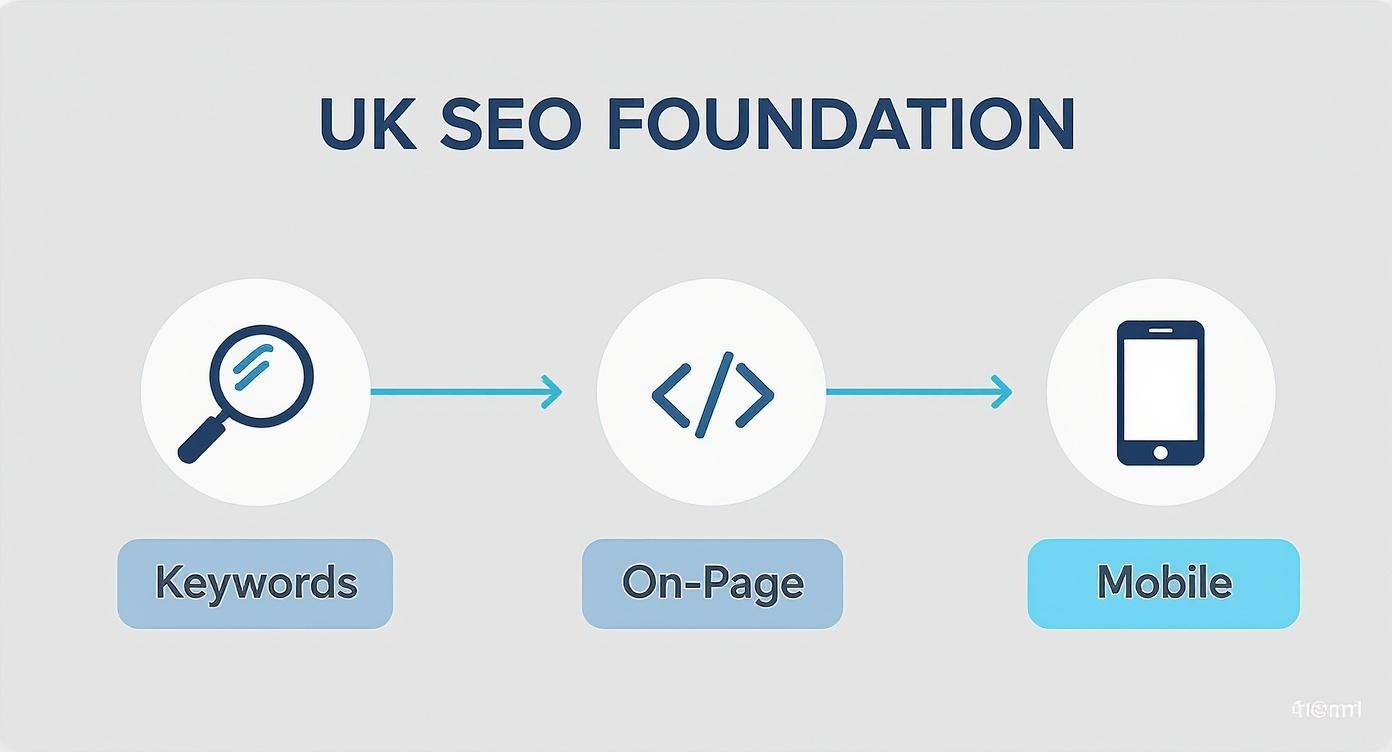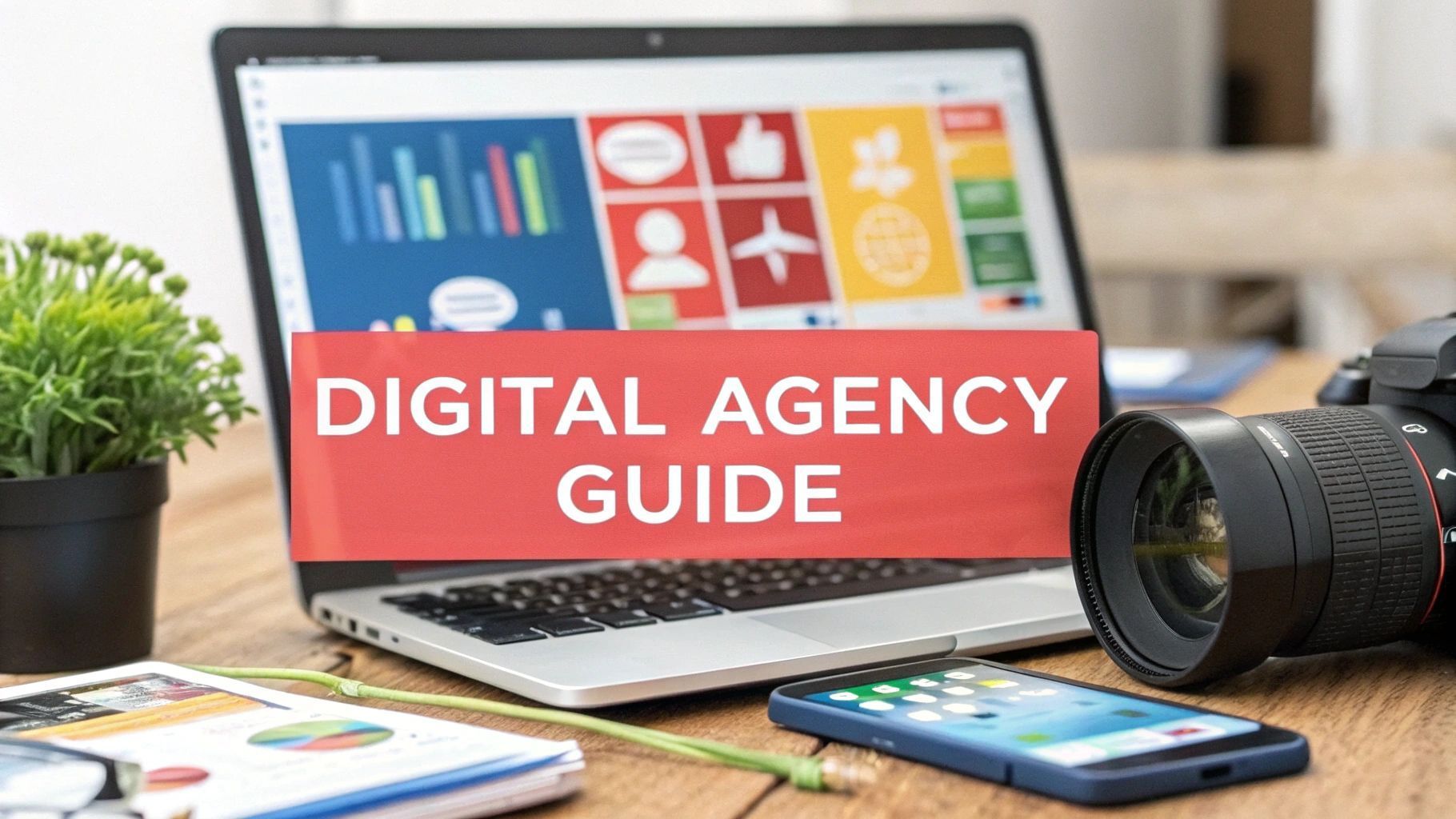How to Increase Website Traffic for UK Sites
If you want to get more traffic to your website, you cannot just throw a few things at the wall and hope they stick. It takes a considered mix of solid technical SEO, content that actually helps people, and a smart promotional game plan.
It all starts with making sure your site is properly set up for search engines, focusing on the keywords people are actually using and ensuring it works flawlessly on a phone. From there, consistently creating genuinely useful content that solves your audience's problems is what will keep them coming back.
Build a Powerful Foundation with UK-Focused SEO
Before you get lost in fancy tactics, you need to get the basics right. Think of your website like a house. If the foundations are shaky, everything you build on top is at risk. In the digital world, those foundations are Search Engine Optimisation (SEO) and a brilliant User Experience (UX), tailored specifically for a UK audience.
Nailing this from the start not only makes you more visible on Google but also ensures that when people do land on your site, they have a smooth, enjoyable experience. This groundwork is what supports everything else you do and is the secret to long term, sustainable traffic growth.
Master Keyword Research for a UK Audience
First things first, you have to understand what your potential customers are actually typing into search engines. That is what keyword research is all about, and it is much more than just guesswork. It is about finding terms that get a decent amount of searches but are also a perfect match for what you offer.
For a UK audience, you need to dig a bit deeper. Think about local slang, regional differences, and British specific search habits. For example, a clothing shop here should be targeting "jumpers," not "sweaters." A plumber in Manchester needs to be all over phrases like "plumber in Manchester," not just "plumber."
A classic mistake is going after the big, hypercompetitive keywords straight away. Instead, focus on "long tail keywords"—these are longer, more specific phrases like "best waterproof walking boots for Scottish Highlands." They get fewer searches, but the people using them know exactly what they want, making them far more likely to convert.
Optimise Your On Page Elements
Once you have got your list of keywords, it is time to weave them into your website's pages. This is what we call on page SEO, and it is how you signal to search engines what your content is about. Here are the key places to focus on:
- Title Tags: This is the clickable headline people see in the search results. Make it catchy and be sure to include your main keyword.
- Meta Descriptions: The little summary under the title tag. It does not directly affect rankings, but a good one makes people want to click.
- Headings (H1, H2, H3): These give your content structure for both readers and search engines. Your main H1 heading should always feature your primary keyword.
- URL Structure:
Keep your URLs clean and descriptive. Something like
yourwebsite.co.uk/services/london-seois miles better thanyourwebsite.co.uk/page-id=123.
If you are a local business targeting a specific part of the UK, running through a comprehensive local SEO checklist is essential for grabbing that local search traffic. It is what helps people in your community find you right when they need you. For a deeper dive into attracting organic visitors, have a look at our guide on organic SEO services in the UK.
Prioritise the Mobile Experience
In the UK, you simply cannot afford to ignore mobile users any more. It is a massive oversight that will cost you traffic, plain and simple. Most of your visitors are probably browsing on their phones, so a mobile first approach is not just a good idea—it is essential.
In fact, mobile devices generated about 66.02% of all web traffic in the UK. This just goes to show how much our browsing habits have changed and why you have to get your mobile strategy right to see a real boost in traffic. You can find more on these mobile traffic statistics on tekrevol.com.
A great mobile experience is about more than just having your site shrink to fit a small screen. It needs to load quickly, adapt perfectly to any device, and be easy to navigate with a thumb. Google also massively favours mobile friendly websites in its rankings, so a poor mobile experience will directly hurt your visibility.
Create Content That Resonates With Your Audience
A technically perfect website is a brilliant foundation, but it is your content that turns a first time visitor into a long term fan. Think of great content as the engine that drives sustainable website traffic. This is not about churning out generic blog posts; it is about creating material that genuinely connects with your audience, answers their burning questions, and actually solves their problems.
A solid content strategy is not a numbers game. It is about being deliberate. Every single piece you publish should be aligned with your business goals and, more importantly, satisfy what a real person is looking for when they type a query into Google. Get this right, and you will establish your brand as a trusted authority, encouraging repeat visits and natural, word of mouth recommendations.
Understand Your Audience's Intent
Before you even think about writing, you need to get inside your audience's head. What are they struggling with? What keeps them up at night? Your content needs to address these pain points head on. In the SEO world, we call this satisfying search intent .
For instance, someone searching for "best walking shoes for Peak District" is not after a history lesson on footwear. They want a straight up comparison, a clear list of pros and cons, and a confident recommendation. Your content has to deliver exactly that, or they will just click back to the search results.
The most effective content feels less like an article and more like a conversation. It anticipates the reader's next question and answers it before they even have to ask. This is how you build real trust and position yourself as an invaluable resource—the cornerstone of long term traffic growth.
Diversify Your Content Formats
If you are only writing standard blog posts, you are leaving traffic on the table. People consume information in all sorts of ways, so mixing up your formats is crucial for casting the widest possible net.
A well rounded content plan should embrace a variety of formats. Here are a few heavy hitters to get you started:
- In depth Guides: These are the comprehensive, cover all bases articles that become go to resources. They are fantastic for attracting organic traffic for broad keywords and stamping your authority on a topic.
- How To Articles: Simple, step by step instructions that solve a very specific problem. They are incredibly practical and highly shareable, making them perfect for driving traffic from both search and social media.
- Video Content: Videos are engaging, easy to digest, and brilliant for tutorials, product demos, or just giving a behind the scenes look at your business.
- Interactive Tools: Think calculators, quizzes, or simple online tools that offer immediate value. These can be absolute magnets for backlinks and repeat visitors.
To give you a better idea of how these elements fit together, this infographic breaks down the core concepts behind a winning traffic strategy.

As you can see, a successful plan starts with keyword research, builds upon on page SEO, and is underpinned by a great mobile experience.
Choosing the right format for the job is key. This table breaks down which content types work best for different marketing objectives, helping you make smarter decisions.
Content Format Effectiveness for Different Goals
| Content Format | Primary Goal | Best For Attracting | Example Tactic |
|---|---|---|---|
| Blog Posts & Guides | Authority Building | Organic Search Traffic | A 3,000 word guide on a core industry topic. |
| How To Articles | Problem Solving | Social Shares, Niche Search | Step by step tutorial with screenshots. |
| Video Tutorials | Engagement & Clarity | YouTube & Social Traffic | A screen recording showing how to use a software feature. |
| Case Studies | Building Trust | High Intent Leads | A detailed breakdown of a successful client project. |
| Interactive Quizzes | Lead Generation | Social & Referral Traffic | "Which [Product] is Right for You?" quiz. |
Ultimately, the best format is the one that serves your audience's needs while pushing you closer to your business goals.
Create a Content Plan and Be Consistent
Publishing content sporadically is like trying to fill a bucket with a dripping tap—it just will not build momentum. Consistency is absolutely vital. It trains both search engines and your audience to keep coming back for more. This does not mean you need to post every day, but you must stick to a realistic schedule, whether that is once a week or twice a month.
A content plan, often called an editorial calendar, is your best friend here. It helps you map out topics weeks or months in advance, making sure everything aligns with your wider marketing campaigns and any seasonal trends. Planning ahead is fundamental to understanding the power of content marketing and its role in turning visitors into loyal customers.
It is also crucial to adapt your strategy based on what is working. Just look at the UK news sector for proof. Express.co.uk saw a massive 32% year on year increase in its UK audience, hitting 17.1 million unique visitors in early 2025. This explosion in traffic was not an accident; it was the result of strategically evolving their content. You can explore the full UK news website traffic report on pressgazette.co.uk for more details. The data is clear: even in the most competitive markets, smart content adjustments can deliver incredible growth.
Amplify Your Reach Through Social Media
Creating brilliant content is a fantastic start, but it is only half the battle. If no one sees it, it does not exist. To really move the needle on your website traffic, you need to get that content in front of the people who matter, and for millions in the UK, that means meeting them on social media.
This is not about just blasting out links and hoping for the best. It is about building a genuine presence on platforms like Instagram, Facebook, and LinkedIn. When you engage with your followers and build a real community, you turn passive scrollers into active visitors who actually want to hear from you.

Choose the Right Platforms for Your Niche
One of the biggest mistakes businesses make is trying to be everywhere at once. The real key to social media success is to focus your energy where your audience actually hangs out. A B2B consultancy, for example, is going to get far more traction on LinkedIn than on TikTok. A fashion brand? They will thrive on the visual first world of Instagram.
To nail down where you should be, ask yourself a few simple questions:
- Where does my ideal customer spend their time? Younger audiences are all over TikTok and Instagram, while more established professionals are still loyal to Facebook and LinkedIn.
- What kind of content am I making? If your work is highly visual—think videos, infographics, or great photography—then Instagram and Pinterest are your best bet. If you are pushing out in depth guides and industry news, LinkedIn and X (formerly Twitter) are a much better fit.
- Where are my competitors winning? Have a look at what they are doing. See which platforms are getting them the most engagement. It is a massive clue as to where you should be focusing your efforts.
Pick one or two core platforms to master first. It is much better to build a meaningful connection with your followers in one place than to spread yourself too thin across five.
Develop a Strategy for Sharing and Engagement
Once you know where you are posting, you need a plan for what you are posting. Just dropping a link with the article title is lazy and ineffective. You need to create posts that feel native to the platform, spark a bit of curiosity, and get people talking.
Let us say you have just published a blog post, "A Guide to Indoor Plant Care." Instead of a boring link post, you could try this:
- On Instagram: Create a sharp, clean Carousel post showing the top 5 tips from your guide. The last slide? A clear call to action: "Tap the link in our bio to read the full guide."
- On LinkedIn: Start a conversation with a thought provoking question. Something like, "What's the biggest mistake you've made with your office plants? Our new guide tackles the most common pitfalls."
- On Facebook: Post a short, snappy video summarising the key takeaways. Then, ask your followers to share their own plant care wins in the comments below.
The goal is to start a conversation, not just make an announcement. Engagement—likes, comments, and shares—is the currency of social media. The more people interact with your post, the more the platform's algorithm will show it to others, amplifying your reach organically.
Leverage Paid Social Advertising Strategically
Let us be honest, organic reach on social media can be tough these days. That is where paid advertising comes in, giving you a powerful way to cut through the noise. It lets you target specific demographics, interests, and behaviours with pinpoint accuracy, ensuring your content lands in front of the people most likely to care.
Social media is a huge driver for UK website traffic. As of early 2025, a staggering 79% of the UK population —that is about 54.8 million people —are active on social media. Platforms like Instagram are a dominant force, with around 33.4 million UK users . With the UK's social media ad market projected to hit £9.95 billion by 2025, it is clear where the opportunity lies. You can find out more about UK social media trends on sproutsocial.com to see the full picture.
You do not need a massive budget to get started. Begin with a small amount to test different ad formats, audiences, and creative. Focus your spend on promoting your best performing content—those cornerstone guides that solve a real problem for your audience. A well targeted ad campaign, combined with a smart organic strategy, can deliver an immediate and measurable boost to your traffic.
If you are ready to get this right, our in depth guide will help you master social media management for your UK business.
Expand Your Authority with Backlinks and Partnerships
If you want to truly scale your website traffic, you have to start thinking beyond your own channels. Nailing your content and on site optimisation is foundational, of course. But the next level of growth comes from building genuine influence and authority across the wider web.
This is where off page SEO, especially backlinks and smart partnerships, becomes a total game changer.
Think of a backlink as a vote of confidence from another website. When a reputable site links to your content, it is a signal to search engines like Google that you are a trustworthy source. The more of these high quality "votes" you gather, the higher your site is likely to rank in search results, driving a serious uplift in organic traffic.

Master the Art of Earning Backlinks
Let us get one thing straight: earning backlinks is not a numbers game. It is about quality. A single link from a respected industry journal is worth more than a hundred links from shoddy, irrelevant directories. The real secret is creating content so genuinely valuable that other people want to reference it.
Of course, this usually means getting proactive. Start by identifying the websites, blogs, and online publications your target audience already reads and trusts. Once you have a solid list, you can start exploring a few proven tactics:
- Guest Posting: Pitch a high value, original article to write for their site. In exchange, you will usually get a link back to your website, either in your author bio or within the content itself.
- Broken Link Building: This one is a classic for a reason. Use a tool to find broken links on other relevant websites. Then, just reach out to the site owner, give them a heads up about the dead link, and suggest your own content as a perfect replacement. It is helpful, not spammy.
- Resource Page Link Building: Hunt for pages that compile useful resources in your niche (think "Best UK Marketing Tools" or "Top Resources for Small Businesses"). If you have got a brilliant guide or tool that fits, drop them a line and suggest they add it to their list.
The common thread here is relationship building. A personalised, genuinely helpful outreach email will always outperform a generic template. Show them you have actually engaged with their content and explain exactly why your link would be a great addition for their audience.
Secure Features and Media Mentions
Beyond just guest posts, getting your brand featured in online publications or mentioned on a podcast can completely change your trajectory. These placements do not just deliver powerful backlinks; they drive waves of direct referral traffic and give your brand's credibility a massive boost.
This is where a bit of digital PR savvy comes in handy. It is all about proactively pitching stories, data, or expert commentary to journalists and content creators in your field. To get a handle on the fundamentals, this guide on What Is Digital PR offers a fantastic overview.
To make this work, you need to think like a publicist. What unique data do you have? Can you offer a sharp opinion on a trending topic? Creating something genuinely newsworthy, like an industry survey or an original research report, is one of the most effective ways to grab media attention and earn those high authority links.
Form Strategic Content Partnerships
Finally, never underestimate the power of a good old fashioned collaboration. Partnering up with non competing brands who serve a similar audience is a brilliant way to cross promote and tap into entirely new pools of potential customers.
This can look like a few different things:
- Co hosting a webinar: Team up with another business to deliver a joint presentation on a topic you both know inside out. Both of you promote it to your audiences, effectively doubling your reach.
- Creating a collaborative guide: Get together with several experts or brands to produce a comprehensive eBook or guide. Each contributor then shares the final piece with their network, creating a promotional ripple effect that drives traffic for everyone involved.
- Running a joint giveaway: Partner on a competition where people need to follow both brands or visit both websites to enter. It is a fast and effective way to generate social buzz and a spike in referral traffic.
These collaborative efforts do not just drive traffic; they build powerful industry relationships and provide immense value to your audience. This strategy is a true cornerstone for increasing website traffic sustainably for the long haul.
Analyse Performance and Refine Your Strategy
Driving traffic is not a one and done job. A strategy that smashes it one month can easily fall flat the next. This is precisely why analysis is your secret weapon, turning hopeful guesses into a clear, data driven plan for real growth.
Without keeping a close eye on your performance, you are flying blind. You have no idea which content is actually hitting the mark, where your best visitors are coming from, or why people are leaving your site. A solid commitment to regular analysis is what separates the websites that stagnate from the ones that see consistent, long term success.
Get to Grips with Your Analytics Tools
Before you can do anything, you need to get comfortable with a couple of incredibly powerful (and free) tools from Google. These platforms give you all the raw data you need to understand how people behave on your site and sharpen your traffic driving tactics.
- Google Analytics 4 (GA4): Think of this as your command centre for user behaviour. It tells you who is visiting, how they found you, which pages they are interacting with, and how long they are sticking around.
- Google Search Console (GSC): This one is all about your site's performance in Google search. It shows you the exact search terms people are using to find you, which of your pages are ranking, and flags any technical gremlins holding you back.
Using these two in tandem gives you the complete picture—what happens on your site and how you are showing up in search.
"Hope is not a strategy. You will always have more success and drive more page views to your blog if you are marketing content to readers who are interested in it, rather than just using a scattergun approach."
This really gets to the heart of it. You cannot just throw content out there and hope for the best. Analytics is the only way to find out what your audience genuinely cares about, allowing you to make strategic moves that pull them in.
Key Traffic Metrics and What They Really Mean
Jumping into analytics for the first time can feel like a lot. There are endless reports and numbers all screaming for your attention. To cut through the noise, just focus on a handful of key performance indicators (KPIs) that give you the most practical insights.
This table summarises the metrics that matter most, what they actually mean, and the best place to find them.
Key Traffic Metrics to Track and Their Meanings
| Metric | What It Measures | Why It Matters | Primary Tool |
|---|---|---|---|
| Users & Sessions | The number of unique visitors and their individual visits. | Gives you a high level snapshot of your site's overall reach and traffic volume. | Google Analytics 4 |
| Traffic Sources | Where your visitors come from (e.g., Organic, Social, Referral). | Helps you see which channels are working so you can double down on them. | Google Analytics 4 |
| Top Pages | The most viewed pages on your website. | Pinpoints your most popular content, which you can then promote more or use as a model. | Google Analytics 4 |
| Bounce Rate | The percentage of visitors who leave after seeing just one page. | A high bounce rate often means your content is not what the user expected. | Google Analytics 4 |
| Queries & Clicks | The search terms people use to find you and how many click through. | A goldmine for new content ideas, showing you exactly what your audience is looking for. | Google Search Console |
Keeping an eye on these metrics will help you answer the big questions. Is your SEO work actually bringing in more organic traffic? Is that new social media campaign sending real people to your site? The data holds the answers.
Turning Insight into Action
Data is completely useless if you do not do anything with it. The final, most crucial step is building a simple, repeatable process for turning what you find into real world improvements.
Here is a straightforward framework to run through each month:
- Check Your Winners: Look at your most popular pages in GA4. Can you update them with new info? Could you create spin off content on similar topics to capture even more interest?
- Analyse Your Channels: Pinpoint your top two or three traffic sources. Put more time, effort, and budget into these proven channels to get the best return.
- Run A/B Tests: Stop guessing. Test different headlines for your blog posts. Try out new calls to action on your landing pages. Let the data tell you which version works best.
- Fix the Underperformers: Find pages in GSC that get impressions in search but have a poor click through rate. Tweak their title tags and meta descriptions to make them more enticing.
By repeating this cycle of analysis and action every month, you create a powerful feedback loop. Every small adjustment is an experiment, and over time, these data backed decisions compound into serious, sustainable website traffic.
Common Questions Answered
When you are trying to grow your website's audience, a lot of questions pop up. Let us tackle some of the most common ones I hear from clients to help you clear up any confusion and sharpen your strategy.
How Long Before I Actually See More Traffic?
This is the big one, and the honest answer is: it depends on your game plan.
If you are playing the long game with SEO, you need patience. It is like planting a tree. You might see the first sprouts in three to six months , but it can take up to a year to see significant, authority building growth.
On the flip side, things like paid ads and sharp social media campaigns can feel like flicking a switch—traffic can start flowing almost instantly. The smartest approach? Do both. Use paid ads for those quick wins and immediate feedback, while your SEO and content marketing efforts are busy building a rock solid foundation for the future.
The real secret is consistency. Dipping in and out gives you patchy results at best. Whether it is SEO, content, or social media, a steady, committed effort is what creates momentum and drives that traffic graph up and to the right.
Should I Focus on Organic or Paid Traffic?
It is not a case of one being ‘better’ than the other. They are two different tools for different jobs, and they work best when used together.
Organic traffic, the kind you earn through SEO, is incredible. It is sustainable, builds genuine trust with your audience, and over time, it costs you far less per lead. The catch? It takes time to get the ball rolling.
Paid traffic, from platforms like Google Ads or social media ads, gives you instant visibility and lets you get hyper specific with your targeting. This is perfect for launching a new product, promoting a specific campaign, or just getting some initial traction. Most winning strategies use paid traffic to pour fuel on the organic fire, not to replace it.
What is the Single Most Important Thing for Getting More Website Traffic?
If I had to boil it all down to one thing, it is this: providing real, undeniable value to a very specific audience .
There is no magic button. Every successful traffic strategy—whether it is SEO, content, or social—is built on a deep understanding of what your audience needs and then delivering on that better than anyone else.
This means creating top notch, relevant content that genuinely answers their questions, solves their problems, or keeps them entertained. All the technical tweaks and promotion tricks in the world will not work if your core content is weak. A foundation of value is the only thing that leads to traffic gains that actually last.
Focus your energy here:
- Know Your Audience: Get crystal clear on who you are talking to and what they actually care about.
- Create Killer Content: Make stuff that is genuinely helpful, insightful, and well produced. No fluff.
- Promote Strategically: Make sure your brilliant content actually gets seen by the right people on the right channels.
Ultimately, value is the engine. Get that right, and you are already halfway to building sustainable, long term traffic growth for your website.
Ready to turn these ideas into a real world plan that gets results for your business? The team at Superhub specialises in building data driven marketing campaigns that deliver sustainable growth.





